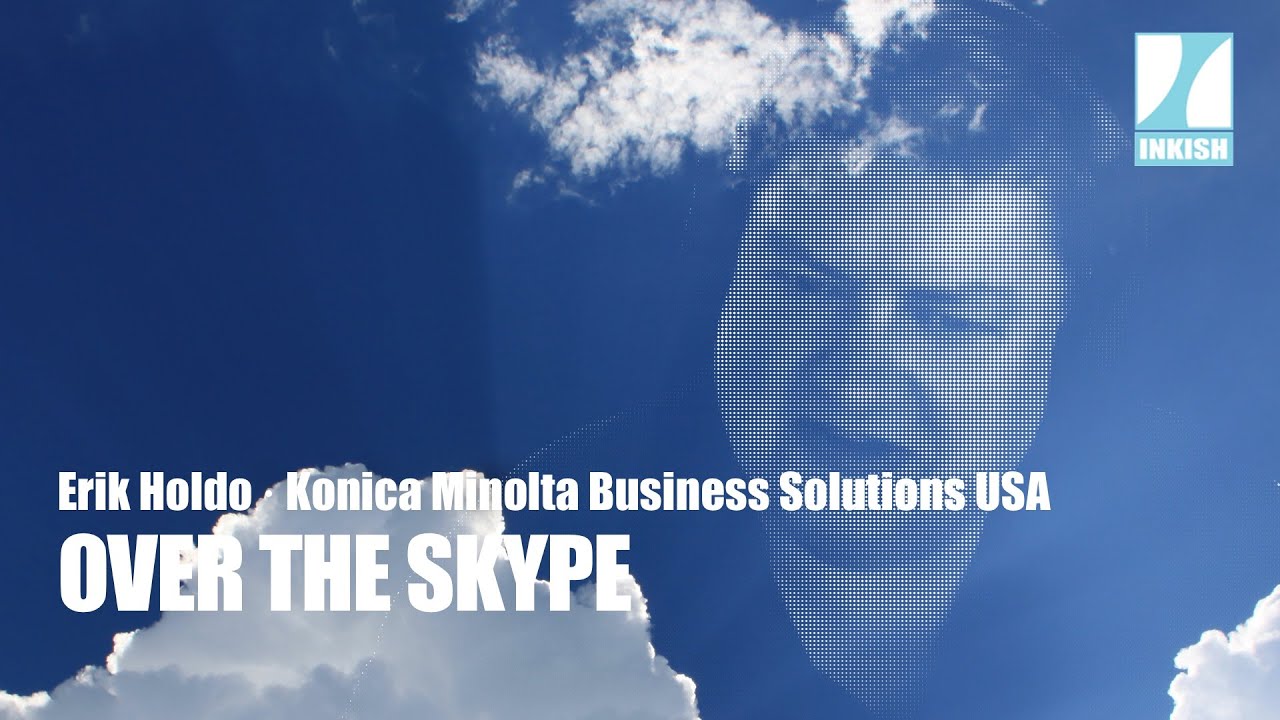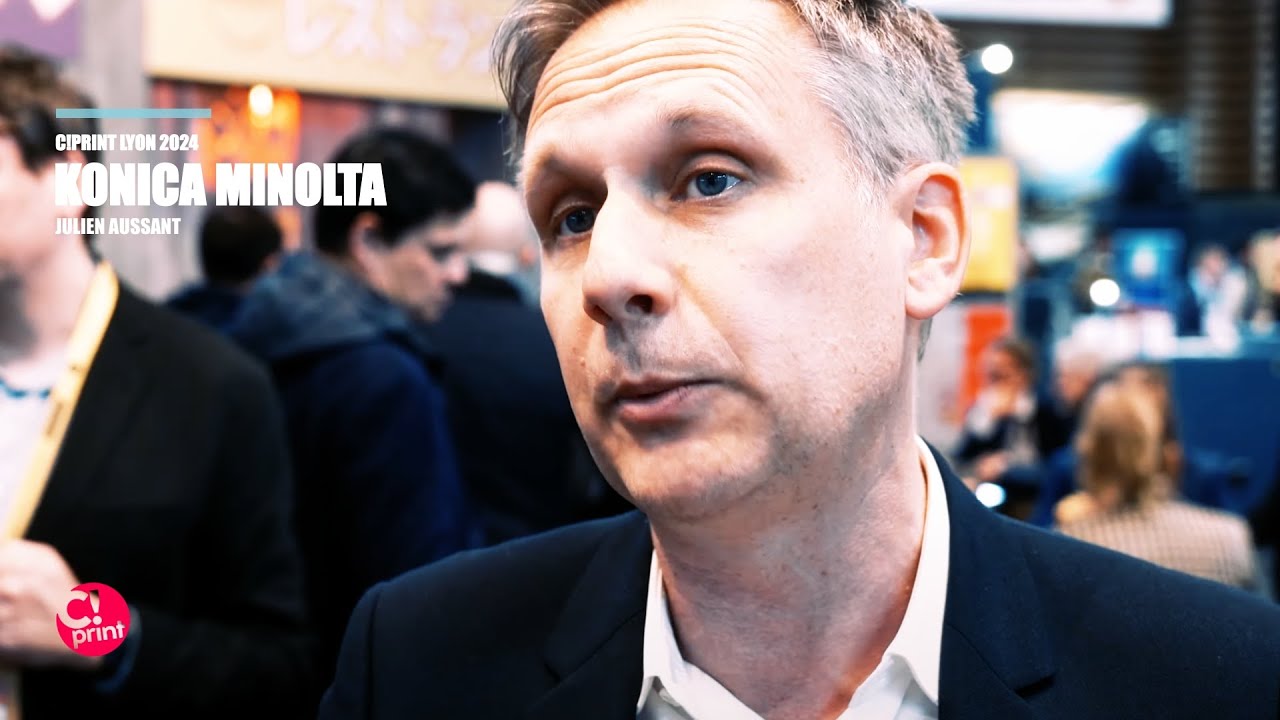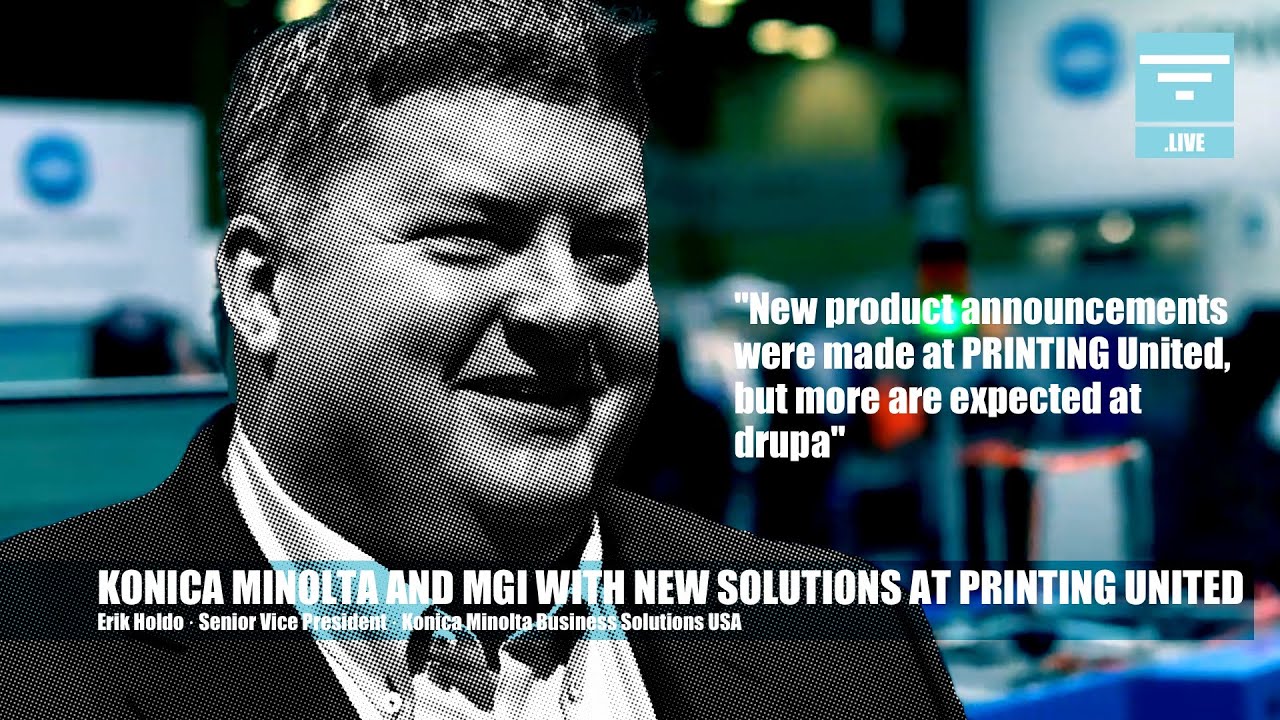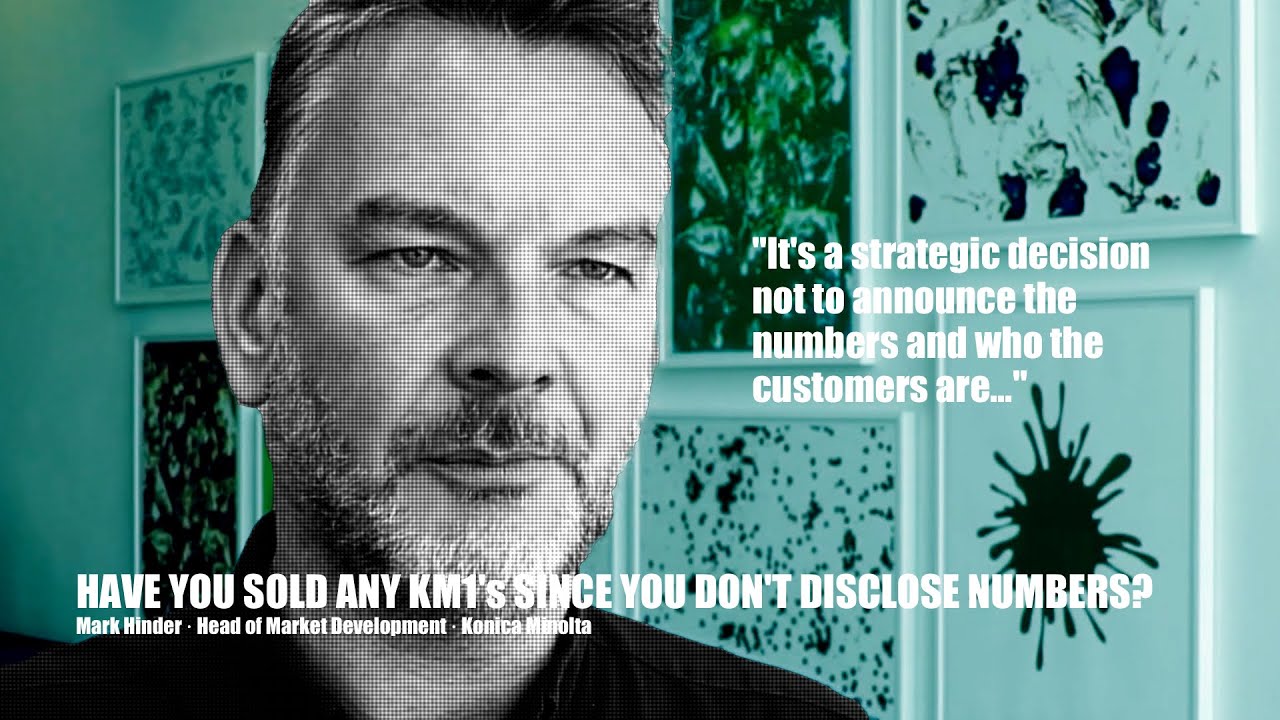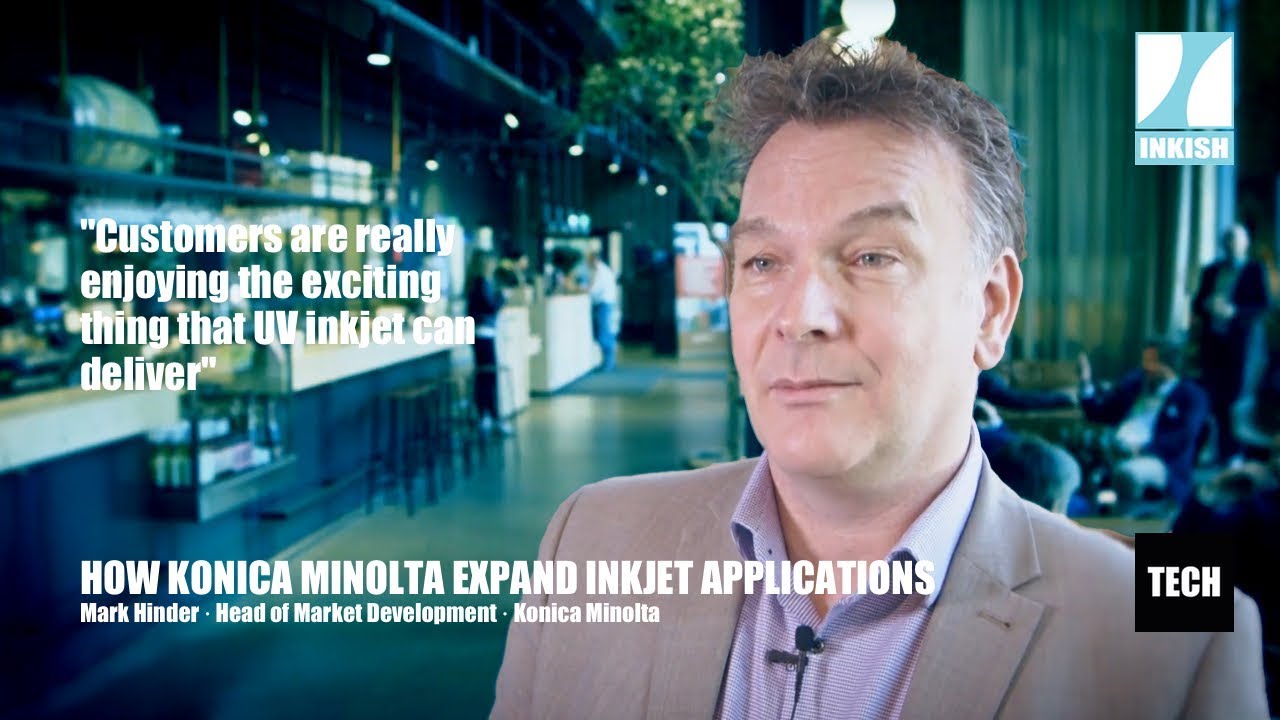Erik Holdo · Over The Skype · Konica Minolta Business Solutions USA
Erik Holdo works for Konica Minolta Business Solutions USA. In this ‘Over the Skype’ session, we get the chance to talk about technology, printing companies, the COVID-19 pandemic, exhibitions, and maybe also how new technology can offer everybody new ways to experience products in the future.
Great session that we really enjoyed!
This is Morten, from Inkish TV, with yet another episode of Over The Skype. I think we have reached number 67, or something like that. And if you really want to have the priority of this, you should have everybody as number one.
But since that is not possible, and to talk to so many people at one time, we take everybody as they come. And I’m very proud and honored today, because I am going to talk to Erik Holdo, who is working for Konica Minolta in the US. So welcome to All of This Skype, Erik.
Thank you very much, Morten. It’s great to be here. Thank you.
And you are in your house in north of Atlanta, you said?
Yes. I’m in an area called Cumming, Georgia, which is about 35 minutes north of Atlanta.
Great. The last time I was in some airport in the US, they always said, “Are you Erik Holdo?” And because you have frequent flyers, so they’re missing you, Erik.
Yeah, I was on the road for about 25 days a month, every single month, and all of a sudden went to zero. So they’re sending me letters saying, “Where are you?”
We miss you, right?
“Have you gone missing?” Yes.
Yeah, yeah, yeah. So, having 25 days a month on the road, I mean, that brings you to a lot of printing companies in the US, right?
It does, yes. It’s my favorite part of my job, is going to visit with our clients and prospects.
So when you have all these visits to the printing companies, I take that a lot of these relations also have … You’re still in contact with them, though we have this pandemic right now. So what is the situation among your clients in these difficult times?
Well, it’s definitely changed. Currently, we’re doing everything via Zoom. It’s extremely busy. I’m on Zoom sessions probably 10 hours a day.
Wow.
So that’s a good thing. That indicates that there’s activity, quite a bit of training that we’re doing of our people, just general concept presentations for new services. We’ve keyed in on what the local trends are, and what’s happened in the last 90 days to our industry. And we’re trying to help clients evolve into something that’s going to save them, or at least help remedy the downfall that we’ve had in the last 90 days.
But it’s been very busy, and probably, honestly, much more efficient, to not be sitting running through an airport every day. The part I miss, which, frankly, our customers don’t want us there yet. They’re struggling, just dealing with having their own labor force, and how do they protect them, and what do they do from a mask perspective or shields, and all sorts of things.
It’s actually created quite a boom in part of the market, manufacturing face shields on our wide format systems, but definitely, some interesting challenges. What I’m seeing, more than anything else, is now a desire for our customers to evolve.
Yeah.
They realize they now must evolve.
Right, yeah. Because I mean, one thing is, the pandemic, it happened, as you said, going from 25 days a month of travel to zero, and that is a very hard stop. And I think that a lot of people, regardless of where in the world we’re talking to people, that the pandemic made a very, very harsh stop on all business, right?
Everybody was, must have been a situation where they’re thinking, “Okay, what now?” And then you have a little time before you move to the next thing, right? And that is where we’re getting it now, I guess. Is that what you mean, right?
Yeah, that’s correct. I mean, if you look at the period here in the US between March and April, there was a 57% decrease or decline in revenues. And that’s, if you look at where it came from, it’s interesting, the specialty products space wasn’t affected nearly as much as the traditional commercial printer and whatnot.
So we’re seeing a lot of new strategies evolve out of this, coming organically out of the printers themselves, with them making decisions now of, “Do I begin offering new services? Or do I focus on a essential printing on COVID products, floor decals, face shields, things like that?” I think some have actually increased.
We have certain clients that have, we’ve seen over 300% increases year over year during this time period. So really, it depends on what services they’re offering,
But that, the service is one thing. But I think it also, to some extent, have something to do with how creative the business owners are, in order to also … You can sit down and die slowly, or you can do something because you want to survive, right?
That’s also very true, yeah. There’s a lot of creativity out there. And I think the general consensus from most of our printers that are going to be around, because there’s certainly a echelon of printers that I think are looking at this period and saying, “Maybe it’s time to move on to something else.” And there’s definitely going to be casualties along the way.
But there are many, who, they’ve come up with their own comfort level of, “All right, we’ve been thinking about doing this. Let’s do that. And effectively go after that part of the market.”
And where we can, we’re trying to assist with that, where it’s relevant. And it may make for a stronger industry at the end of this.
Hmm. What about change? Because some of the people I’ve been talking to during all these weeks of working from home, with Skype as the primary source for content, we have been talking about whether the pandemic is pushing change a little bit faster, especially when you go into the digital space. Do you think that is something that you see, or …
As far as overall volume increases, the digital space is definitely increasing. I mean, shorter runs have created, and more diversity has created opportunity.
But Erik, I was thinking of, sorry to interrupt you. But I was thinking maybe more from the perspective that everybody knows that everything eventually will be digital, okay?
Now we have a situation where there’s not so much work. Maybe the business owners sit down and think, “Okay, what is the next step for my business? Maybe now is the time to look into the tool instead of analog.” And that might be something that is pushed forward due to the pandemic.
Do you see that as a trend? Or is that totally wrong?
No, no, that is not totally wrong. I do think that those that are good at what they do on the analog side … I mean, look, let’s not kid ourselves, the analog product manufacturers have done a very good job of making shorter run lengths possible, making it more cost-effective to be running an offset environment, for example.
So it’s not only the domain of digital. I think it’s more important for them to have an understanding of the new paradigm for customer expectations regarding flexibility. Most companies here in the US have made some sort of transition to digital already.
Where you see offset work still being done, it’s in general, such long run lengths, and those aren’t going to be going anywhere. Now, I will tell you that there’s an interesting side effect of this pandemic, which, we’ve talked about the increase in packaging and label over the years, that was always identified as one of the biggest growth areas.
That’s really grown, at this point, because now you have people making products at home. You have home craft, the craft products industry.
So the need for a-
And that’s forcing, in some cases-
So the need for smaller orders, that could do.
Yeah. So the need for smaller print runs, and-
Yup, for smaller orders.
And faster turnarounds, and …
Right, but still with the elegance of what you get in a more traditional environment. So, embellished packaging, something with shelf shouts. Something that speaks to you from a shelf is still important, because the maker of that craft product still wants it to, they want it to elevate, as a matter of fact, above what the standard retail products are.
Yeah.
The interesting thing is, of course, you’re now looking at that product on Amazon, or on some e-commerce site. You’re not looking at it in a store anymore, unless it’s wine.
Yeah.
I will tell you that the wine industry has not been hurt one iota, the alcohol industry has not been hurt. Those are apparently considered essential services here in the US, so, and all-
But you knew that already, I know that.
All along the way, you could walk in and buy a wonderfully embellished foiled bottle of wine, or a bottle of alcohol. They weren’t really affected. So it really, it’s interesting. Because like I said, there have been some of our clients that have increased their revenues threefold, where others still maintain the problem.
It’s interesting, though. I think that that change may not necessarily be, “We’re going to do, focus more on digital, use this downtime to go to digital,” and be more about, “We’re going to use this downtime to provide additional services. We’re going to bring in augmented reality, and how that plays, how the brand engagement can be driven from the brand owner, all the way down to the consumer,” rather than all of the middle letters of distribution that have blocked the brand from that consumer.
So, okay. So if I get you, right, then it’s like, if the demand is changing towards digital, it’s maybe more because the demand from the consumers are changing, and because the variations of small businesses are growing. So then it’s an opportunity for, also the PSPs, to offer new products, new services, to a smaller segment in the market.
But if you look at that from a PSP perspective, I don’t think that is bad for a digital vendor like yourself, but I don’t think it’s bad for a business perspective, because I think the value of the print when you do short runs with a high level of quality, or a high level of embellishment, is way more valuable than doing long runs, right?
Absolutely. As that volume increases, now of course, the thing that frightens many, I think, is, “Okay, if I am doing a run of 100,000, and now I’m going to tell them I can do a run of 10,000, I’m going to miss out on all this revenue.”
What’s not sinking in is, “No, no, no. You’re going to pick up 10 jobs running 10,000, and your profitability per job isn’t going to be 3% or 6%. It’s going to be 22% or 25%.” And that’s part of it, but there’s really, again, I have to stress, there is this change in expectation by the brand manager, whoever it is that owns that product that’s being produced, that printed product.
I don’t care if it’s a book, or it’s a package or a label. Whoever the brand manager is, ultimately, that consumer engagement is where there’s additional revenue to be had for the brand. To the extent that printers are understand whether they’re offset, flexo shops, whatever it might be, or digital shops, it doesn’t matter.
They need to be enabling that technology to the brand, so that they can engage directly with that consumer. And there are ways to do it now that have never existed before. And it’s very exciting, and it actually can provide print with a boost, rather than compete with it, as other technologies do.
Hmm. And that leads me, of course, to talk a little bit about products, because I think that, of course, your flagship there became, one’s been updated to the e-version, right?
Yeah.
But you also sell the MTIs everywhere, of course, as part of Konica Minolta. And then last, but not least, when you talk about this also, your label printers, right? So you have actually for, I think if you look at your product range, data actually covers a nice hot spot, right?
Absolutely. Really, across the gamut of the packaging label marketplace, even to an extent, I think you’re going to start seeing things for corrugated other products as well.
You think so?
Yeah. Ultra-ultra, short run, folding carton products. It can even be handled on the toner side of things.
We’ve brought out a new toner device as well, that’s called the C14000. That product is, while it is a toner product, the gamut is like nothing else on the market. It can handle 450 GSM. It can handle 13- by 35-inch sheets, duplexed.
So you can start getting into that folding carton side of the business, for a short run, at a far lower cost than anything else. But yes, once you move into the 1e and those products, it gives you a packaging.
But that also leads to the conclusion that, well, not a conclusion, but the summary, at least, that when you talk about that, the pandemic has started with people being more creative from home, creating smaller products, and new products. And suddenly you see them on the Amazon rather than finding them in the shop.
Yeah.
I mean that lower level of people, lower level in a positive sense. I mean, if you look at all these things, it will lead to a new demand for new types of products that you can’t do in an offset, at least not profitable, right?
There’s a fundamental seeding of the market that’s occurring right now. And those seeds are being planted in the kitchens and garages of tens of thousands of people around the world. And some of those are going to grow into very robust trees.
They’re going to create new opportunities for us in the industry. So in the end result, this pandemic is a temporary inconvenience. It’s a horrible situation for people who have lost loved ones, of course, but just from a business perspective, it’s an interruption.
It’s a very significant interruption, but it’s an interruption. It’s not a cancellation.
I think that is something that people tend to forget, is that basically, when you have a crisis that opens up for the need of being creative, because people won’t lie down and just wait to pass away. They basically want to invent ideas, to figure out how to thrive.
So speaking about that, and Konica Minolta, are you in a position where you can guide your customers, with also these perspectives of business opportunities, maybe for … I mean, because you have obviously have both lost large customers and small customers, but how do you get? And when, with all the printing companies that you have been visiting all the years, are you able to get that message across to these people?
Oh, absolutely. Yeah. I think there’s generally, in the market overall, whether smaller, up to very large, there is a certain degree of hope, and there’s a confidence that things will be better, and this will make us a stronger industry overall.
Frankly, at certain points in time, and in almost any situation, you need to cull the bad out of certain industries. And complacent complacency had been the thing that we needed to cull out of this industry. Not transforming, just looking at print as print, rather than communications.
I think that’s all coming back to roost now. From what I see, we have very confident customers that this is going to be ultimately good for them. Honestly, it’s probably allowed some of them to rightsize their operations.
If they can do so safely, if they can reopen, or they can continue to operate in a safe and effective manner, I think that there’s a silver lining in all this.
Changing a little bit subject, from a business perspective, from a Konica Minolta perspective, so, are you very influenced by the pandemic? Or do you manage to reach all those buckets? Or how is that for you guys?
Well, I think anybody who has not been affected is not alive. I mean, clearly it has had effects throughout the business landscape here. So yes, there are effects. But out of those effects, again, we try and find new opportunities.
We’ve launched some new technology for when a employee, let’s say, comes into a print facility to automatically screen them, temperatures …
Oh, really? Wow. Smart.
And to do health screening. So that’s now an offering in our Return to Work program. Our product marketing team and technology teams came together very quickly and created some fantastic opportunities, to help promote remote workplace activity.
So whether it’s providing a turnkey solution with a laptop and a small office copier for home and whatnot, basically to update them, so that they can operate fully from home, but also our Cloud services, our IT Services Group, with virtualization of servers and remote management and cybersecurity. There’s a lot that Konica Minolta has been doing to enter this digital transformation that we had already been doing.
And now, it’s all sort of gathering together, in a cohesive synergistic manner, to be able to provide new solutions in, and change. So again, in the end, we’re going to be a stronger, better company, even though there might be moments of discomfort that this has caused everybody.
Yeah, yeah. I mean, if I look at Inkish, for example, we had to lay off two people. It’s been financially very tough times for us, because we can’t go out to filming. So obviously, we have fewer customers.
For us, it’s great now, because Europe is a little ahead of the pandemic. So we can now start traveling a little bit, at least, right? So now, it’s more about getting the customers back on track, so they want to be filmed. So I totally understand what you say.
So I think that, for my audience, I think we have a pretty equal square, a split from Americans to Europeans watching our channel. I was a little bit curious about, if you look at Konica Minolta, we also spoke, before we started recording, about the trade shows.
How big of an influence is it for Konica Minolta, and your communication, that the trade shows are postponed when you release new products? Is that something that is giving you a headache, or how do you manage that?
I think that the gut reaction is to say that this is a problem. We have to be able to show these large, fantastic, wonderful pieces of equipment.
But the reality is, our team very quickly pivoted. We started doing virtual demonstrations. We have a phenomenal facility in Ramsey, New Jersey, the Customer Engagement Center. And we have all of our big equipment there, that somebody can have a virtual open house.
They can be walked through the demonstration. They can see their application running in real time. And so, we pivoted very, very quickly. And we started making those services available quickly.
Now, for example, I did a demonstration with one of our large printer customers the other day. We sent them in advance a packet of sample materials that we were going to be discussing. And really, I don’t think we lost a step.
Wow.
And what it didn’t require is people shuttling across the country, and hotel stays and meals, and so on and so forth. So really, in this period of time where conservation of capital is important, I think we’re effectively able to do that.
Now, you can never replace, I think, the benefit of the contacts at these shows, the happen to walk by a booth and see something that you didn’t know existed.
That you didn’t experience, yeah, precisely.
Yeah, yeah. That’s going to be missing. And there have to be new ways of providing that.
So hopefully, those that create these shows, whether it’s the NAPCO here or Printing United group here, or what have you, hopefully they will be transitioning, not to just a virtual showcase, which I think is fine, but it has to be done right.
It has to be done with engagement. Because otherwise it’s a Zoom session, and you’re not going to move the needle, with that.
But that is as we spoke about, when it comes to the PSPs and to the vendor side, I think that there’s an opportunity too, right? Because the people that cracks that can also have a relatively good future ahead of them, because everybody needs to bridge between the printers, the vendors, and hopefully also the independent media, like ourself and our friends in the American trade media. So I think that that is an opportunity to see there’s an opportunity, rather than as a obstacle.
I think so. Absolutely. And, as I said, it’s an opportunity for growth for all of us.
Yeah. So, if you look at what’s specifically related to the pandemic, but more in general terms, how is the competitive situation among the digital vendors?
I mean, a lot of equipment from a lot of vendors have enrolled out also, due to the postponing of Drupa. HP has a very broad program, Canon rolled out new inkjet devices. I can’t recall if I saw anything from Brico, but I saw that you’d brought the 14000, and also the 1er.
Yeah.
So how does the competitive space look, in your opinion?
It’s really a continuation of what we were already expecting. I mean, I haven’t seen anything that’s terribly surprising, or honestly, terribly innovative.
I think I will put up our product offering against anybody on the market, in the spaces that we compete. I should hope I would be confident to say that.
The reality is, when it got postponed, there were some great technology concepts that we were going to present, some new technologies, that now we have to sit back and weigh on, when we’re going to make those releases. So there’s-
Okay, so that shows, so you have a, I wouldn’t say backlog, but you have some new technologies and some new potential products that you have decided to postpone, because of the pandemic, onto all times?
Yeah. I think, rather than say, postpone, I don’t want to represent that necessarily one way or another, but what I would say is, we, in some cases, do technology previews.
Ah, okay, yeah.
For example, when we first showed the KM-1, we showed it in 2012 at Drupa.
I remember.
And yeah. And so do I.
Yeah.
And so, if you think about it, we really actually didn’t start selling that product until almost 2016. So it’s not that it has to postpone, it’s that it-
Ah, it’s more of-
It eliminates some of that-
Yeah.
Yeah, yeah.
So it’s more about having the right time to actually have the technology showcase, so a lot of people and you get the attention for it, so people understand what it is you are actually presenting.
Sure. Correct. And there are other ways of doing that, and talking to folks like yourself in the media help us spread that word, when it’s appropriate. But in some cases, we may just move into a proof of concepts with customers, not necessarily needing to do the preview.
Because the previews, the technology previews, are sort of a rite of passage in these shows. I mean, you have to have something to show. The reality is, you don’t have to have something to show, as long as you actually have technology being invested in, and new products.
So, absolutely. I mean, we haven’t stopped our innovations across the board, in both the toner and inkjet. And I look forward to being able to present those at some point in the future.
Just give me a call. That would be nice.
Absolutely, absolutely, absolutely.
That’s perfect. Erik, we have been talking for half an hour. It’s been wonderful.
Anything that you would like us to talk about before we end the session? I told you that it’s a very free and open conversation. I have really enjoyed myself. So feel free if you want to share something.
Well, no, I just think in general, we have to have faith and confidence in our industry. We have to support those that are looking to do things new, in a new way, in a better way.
Sometimes those ideas can come right from the people that are standing around you, that in the past … My concern in our industry sometimes is, “We’ve always done it this way. We’re going to continue to do it this way.”
And now’s not the time for that. Now’s the time to start gathering variety of opinions, and expanding what the print industry is.
Right.
You know, I wish us to be the communications industry, not the print industry.
So, and I take it that you would like to, both as an individual, but also as a representative of Konica Minolta, be ahead of that vision, right?
Yeah. Absolutely. If it wasn’t something I thought that we were doing and leading the charge on, I wouldn’t say it.
Yeah.
There’s absolutely an opportunity, and Konica Minoltas, it’s been a great company to work with, because they support broadening of our view of what the, what our industry is. So it’s been very good.
I forgot to ask you in the beginning, how long time have you been working for Konica Minolta?
Well, if you count the Danka, this is now 17 years.
Okay.
So, 34 years in the industry, 17 years of it, half of my professional life with Konica Minolta.
So I can call you Mr. Konica Minolta from now on, right?
I’ll tell you. We have people that have been here 30 years.
Ah, okay.
30, 35, 40 years, so-
You’re a kiddo, you’re a kiddo.
I’m still a kid, yeah. Yeah, exactly.
Yeah, yeah. That’s great.
Well, Erik, I appreciate that you took the time. I know that you have a busy schedule, so thank you very much for taking time to talk to me here on Over The Skype.
So thank you, and all the best, and stay healthy for everybody, of course.
Right.
So, goodbye.
Thank you very much. Yeah, we had a breaking up of the audio right there again, so-
Oh, sorry. I just [crosstalk 00:30:36]-
But thank you very much for inviting me, I really …
Okay. Your turn.
Yeah.
Your turn.
Thank you very much for inviting me. I appreciate it. It’s been wonderful talk to you again, and hopefully, I get to see you some time in person.
I’m sure. Thank you, Erik.






























































